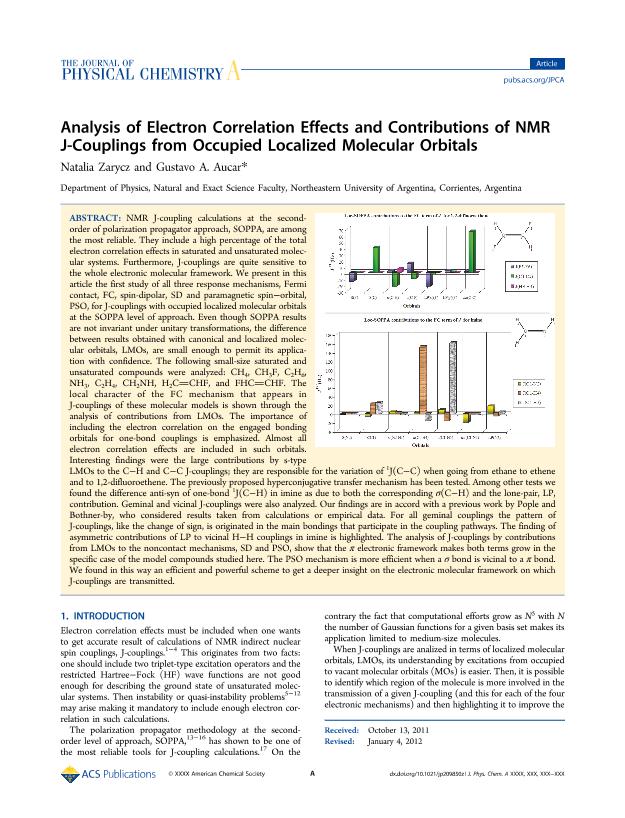Mostrar el registro sencillo del ítem
dc.contributor.author
Zarycz, Maria Natalia Cristina

dc.contributor.author
Aucar, Gustavo Adolfo

dc.date.available
2021-12-27T15:08:57Z
dc.date.issued
2012-01
dc.identifier.citation
Zarycz, Maria Natalia Cristina; Aucar, Gustavo Adolfo; Analysis of electron correlation effects and contributions of NMR J-couplings from occupied localized molecular orbitals; American Chemical Society; Journal of Physical Chemistry A; 116; 4; 1-2012; 1272-1282
dc.identifier.issn
1089-5639
dc.identifier.uri
http://hdl.handle.net/11336/149283
dc.description.abstract
NMR J-coupling calculations at the secondorder of polarization propagator approach, SOPPA, are among the most reliable. They include a high percentage of the total electron correlation effects in saturated and unsaturated molecular systems. Furthermore, J-couplings are quite sensitive to the whole electronic molecular framework. We present in this article the first study of all three response mechanisms, Fermi contact, FC, spin-dipolar, SD and paramagnetic spin−orbital, PSO, for J-couplings with occupied localized molecular orbitals at the SOPPA level of approach. Even though SOPPA results are not invariant under unitary transformations, the difference between results obtained with canonical and localized molecular orbitals, LMOs, are small enough to permit its application with confidence. The following small-size saturated and unsaturated compounds were analyzed: CH4, CH3F, C2H6, NH3, C2H4, CH2NH, H2CCHF, and FHCCHF. The local character of the FC mechanism that appears in J-couplings of these molecular models is shown through the analysis of contributions from LMOs. The importance of including the electron correlation on the engaged bonding orbitals for one-bond couplings is emphasized. Almost all electron correlation effects are included in such orbitals. Interesting findings were the large contributions by s-type LMOs to the C−H and C−C J-couplings; they are responsible for the variation of 1J(C−C) when going from ethane to ethene and to 1,2-difluoroethene. The previously proposed hyperconjugative transfer mechanism has been tested. Among other tests we found the difference anti-syn of one-bond 1J(C−H) in imine as due to both the corresponding σ(C−H) and the lone-pair, LP, contribution. Geminal and vicinal J-couplings were also analyzed. Our findings are in accord with a previous work by Pople and Bothner-by, who considered results taken from calculations or empirical data. For all geminal couplings the pattern of J-couplings, like the change of sign, is originated in the main bondings that participate in the coupling pathways. The finding of asymmetric contributions of LP to vicinal H−H couplings in imine is highlighted. The analysis of J-couplings by contributions from LMOs to the noncontact mechanisms, SD and PSO, show that the π electronic framework makes both terms grow in the specific case of the model compounds studied here. The PSO mechanism is more efficient when a σ bond is vicinal to a π bond. We found in this way an efficient and powerful scheme to get a deeper insight on the electronic molecular framework on which J-couplings are transmitted.
dc.format
application/pdf
dc.language.iso
eng
dc.publisher
American Chemical Society

dc.rights
info:eu-repo/semantics/openAccess
dc.rights.uri
https://creativecommons.org/licenses/by-nc-sa/2.5/ar/
dc.subject
NMR
dc.subject
POLARIZATION PROPAGATORS
dc.subject
LOC-SOPPA
dc.subject.classification
Física de Partículas y Campos

dc.subject.classification
Ciencias Físicas

dc.subject.classification
CIENCIAS NATURALES Y EXACTAS

dc.title
Analysis of electron correlation effects and contributions of NMR J-couplings from occupied localized molecular orbitals
dc.type
info:eu-repo/semantics/article
dc.type
info:ar-repo/semantics/artículo
dc.type
info:eu-repo/semantics/publishedVersion
dc.date.updated
2021-12-03T20:39:49Z
dc.journal.volume
116
dc.journal.number
4
dc.journal.pagination
1272-1282
dc.journal.pais
Estados Unidos

dc.description.fil
Fil: Zarycz, Maria Natalia Cristina. Universidad Nacional del Nordeste; Argentina. Consejo Nacional de Investigaciones Científicas y Técnicas. Centro Científico Tecnológico Conicet - Nordeste; Argentina
dc.description.fil
Fil: Aucar, Gustavo Adolfo. Consejo Nacional de Investigaciones Científicas y Técnicas. Centro Científico Tecnológico Conicet - Nordeste. Instituto de Modelado e Innovación Tecnológica. Universidad Nacional del Nordeste. Facultad de Ciencias Exactas Naturales y Agrimensura. Instituto de Modelado e Innovación Tecnológica; Argentina
dc.journal.title
Journal of Physical Chemistry A

dc.relation.alternativeid
info:eu-repo/semantics/altIdentifier/doi/http://dx.doi.org/10.1021/jp209850z
Archivos asociados
